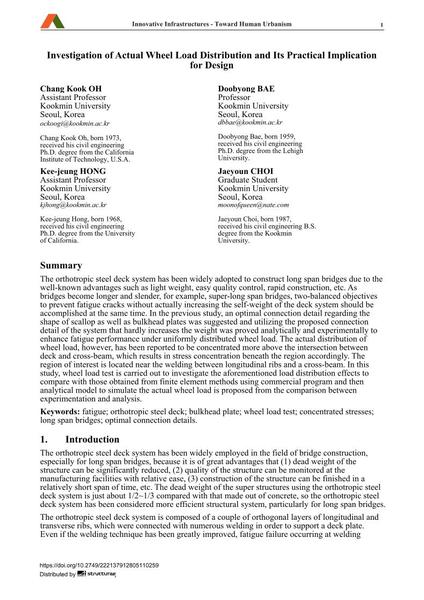Investigation of Actual Wheel Load Distribution and Its Practical Implication for Design

|
|
|||||||||||
Détails bibliographiques
| Auteur(s): |
Chang Kook Oh
Doobyong Bae Kee-Jeung Hong Jaeyoun Choi |
||||
|---|---|---|---|---|---|
| Médium: | papier de conférence | ||||
| Langue(s): | anglais | ||||
| Conférence: | 18th IABSE Congress: Innovative Infrastructures – Towards Human Urbanism, Seoul, Korea, 19-21 September 2012 | ||||
| Publié dans: | IABSE Congress Seoul 2012 | ||||
|
|||||
| Page(s): | 54-59 | ||||
| Nombre total de pages (du PDF): | 6 | ||||
| DOI: | 10.2749/222137912805110259 | ||||
| Abstrait: |
The orthotropic steel deck system has been widely adopted to construct long span bridges due to the well-known advantages such as light weight, easy quality control, rapid construction, etc. As bridges become longer and slender, for example, super-long span bridges, two-balanced objectives to prevent fatigue cracks without actually increasing the self-weight of the deck system should be accomplished at the same time. In the previous study, an optimal connection detail regarding the shape of scallop as well as bulkhead plates was suggested and utilizing the proposed connection detail of the system that hardly increases the weight was proved analytically and experimentally to enhance fatigue performance under uniformly distributed wheel load. The actual distribution of wheel load, however, has been reported to be concentrated more above the intersection between deck and cross-beam, which results in stress concentration beneath the region accordingly. The region of interest is located near the welding between longitudinal ribs and a cross-beam. In this study, wheel load test is carried out to investigate the aforementioned load distribution effects to compare with those obtained from finite element methods using commercial program and then analytical model to simulate the actual wheel load is proposed from the comparison between experimentation and analysis. |
||||
